SUMMARY OF FINDINGS
INTRODUCTION
Technological innovation and labour force changes, as well as the application of new work practices, have led to major changes in the occupational composition of the Australian labour force and in the tasks and skills required of workers. These skills are important not only from the point of view of the labour market, they are increasingly seen as important for an individual's ability to participate fully in modern society. Different life contexts, including home and community, impose skill demands on individuals at all stages of their lives. Literacy is one important underlying skill that is the subject of this survey.
ABOUT THIS SURVEY
The Adult Literacy and Life Skills Survey (ALLS) was conducted in Australia as part of an international study coordinated by Statistics Canada and the Organisation for Economic Co-operation and Development (OECD). In 2003, the following countries were involved in the first wave of the study: United States of America, Bermuda, Canada, Italy, Mexico (state of Nuevo Leon), Norway and Switzerland. Results comparing Australia and the first wave countries (with the exception of Mexico as their results were not available at the time of this publication) are included in tables 5 to 7. Australia participated in the second wave of enumeration with Hungary, the Netherlands, New Zealand and South Korea.
The ALLS is designed to identify and measure literacy which can be linked to the social and economic characteristics of people both across and within countries. The ALLS in Australia was jointly funded by the Department of Education, Science and Technology (DEST), the Department of Employment and Workplace Relations (DEWR) and the Australian Bureau of Statistics (ABS). The ALLS measured the literacy of a sample of people aged 15 to 74 years.
MEASURES OF LITERACY
The ALLS provides information on knowledge and skills in the following four domains;
- Prose literacy: the ability to understand and use information from various kinds of narrative texts, including texts from newspapers, magazines and brochures.
- Document literacy: the knowledge and skills required to locate and use information contained in various formats including job applications, payroll forms, transportation schedules, maps, tables and charts.
- Numeracy: the knowledge and skills required to effectively manage and respond to the mathematical demands of diverse situations.
- Problem solving: goal-directed thinking and action in situations for which no routine solution is available.
As a by-product of the above domains, a fifth domain measuring health literacy was produced. Health literacy is defined as the knowledge and skills required to understand and use information relating to health issues such as drugs and alcohol, disease prevention and treatment, safety and accident prevention, first aid, emergencies, and staying healthy.
For each literacy domain, proficiency is measured on a scale ranging from 0 to 500 points. To facilitate analysis, these continuous scores have been grouped into 5 skill levels (only 4 levels were defined for the problem solving scale) with Level 1 being the lowest measured level of literacy. The relatively small proportions of respondents who actually reach Level 5 often results in unreliable estimates of the number of people at this level. For this reason, whenever results are presented by skill level, Levels 4 and 5 are combined. To assist with interpreting the results, Level 3 is regarded by the survey developers as the "minimum required for individuals to meet the complex demands of everyday life and work in the emerging knowledge-based economy" (Learning a Living: First results from the Adult Literacy and Life Skills Survey', available from Statistics Canada's website (www.statcan.ca)). For a full description of the levels, refer to Appendix 1.
LITERACY IN 2006
Approximately 7 million (46%) Australians aged 15 to 74 years had scores at Level 1 or 2 on the prose scale, a further 5.6 million (37%) at Level 3 and 2.5 million (16%) at Level 4/5. Results for document literacy were similar to prose. There were 7 million (47%) Australians at Level 1 or 2 on the document scale, 5.4 million (36%) at Level 3 and 2.7 million (18%) at Level 4/5. On the numeracy scale, approximately 7.9 million (53%) Australians were assessed at Level 1 or 2, 4.7 million (31%) at Level 3 and 2.4 million (16%) at Level 4/5. On the problem solving scale, approximately 10.6 million (70%) Australians were assessed at Level 1 or 2, 3.7 million (25%) at Level 3 and 800,000 (5%) at Level 4 (table 1).
1 Proportion at each skill level
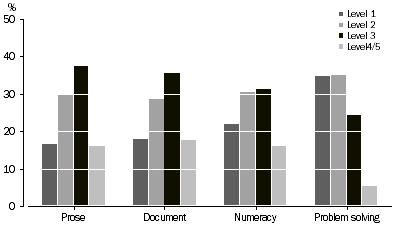
On the health scale, approximately 9 million (60%) Australians attained scores at Level 1 or 2, a further 5.2 million (35%) were at Level 3 and 900,000 (6%) were at Level 4/5
(table 1).
HAVE AUSTRALIANS' PROSE AND DOCUMENT LITERACY SKILLS IMPROVED IN 2006?
Of the five literacy domains available from the 2006 ALLS only two, prose and document literacy, are directly comparable to those derived from the 1996 Survey of Aspects of Literacy (SAL). The quantitative literacy domain, derived from the 1996 SAL, was narrowly focused on numeracy competency and did not necessarily emphasise real-life tasks which demand more diverse numeracy skills. Consequently, an expanded concept of adult numeracy has been incorporated in the 2006 ALLS numeracy scale. As a result of these conceptual differences, the two scales can not be compared. The problem solving and the health literacy domains are additions to the 2006 ALLS and hence no time series information is available.
There were small, but statistically significant changes in the achieved prose and document literacy levels of Australians from 1996. There was a statistically significant decrease in the proportion of people at Level 1 for both prose (from 20% in 1996 to 17% in 2006) and document literacy (from 20% in 1996 to 18% in 2006). The proportion of people at Level 2 for document literacy remained stable, while there was a statistically significant increase from 28% to 30% in the proportion of people attaining Level 2 for prose literacy. The proportion of the population at Level 3 on the prose scale increased significantly from 35% to 37%. There was no change in the proportion of people attaining Level 3 on the document scale (36%). Similarly, the proportion of the population at Level 4/5 on the prose and document scale did not change significantly (table 2).
2 Prose literacy by skill level - 1996 to 2006
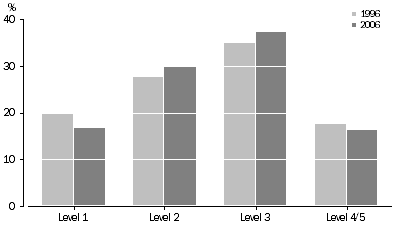
AGE
Literacy levels tended to decrease with age, with higher proportions of people in the older age groups attaining skill scores lower than Level 3. The exception to this was the 15 to 19 years age group, which had lower levels of literacy than the 20 to 24 year age group. Of those aged 15 to 19 years, 52% attained skill scores lower than Level 3 on the prose scale, 47% on the document scale and 57% on the numeracy scale, compared to 37% on both prose and document scales and 45% on the numeracy scale for those aged 20 to 24 years (table 1).
3 Proportion at skill level 1/2, by age
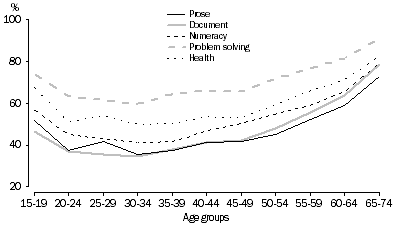
Comparing prose and document literacy levels in 1996 to those in 2006, there were statistically significant changes across the older population, with decreases in the proportions attaining Level 1, and increases in the proportions attaining Level 2 and 3. For the prose scale, in 2006 there were fewer people over the age of 50 years attaining Level 1, more people aged 40 to 44 years attaining Level 2, and more people aged 55 to 64 years attaining Level 3. On the document scale, there was a statistically significant decrease in the proportions of 55 to 64 year olds attaining skill Level 1. For all other age groups, there were no statistically significant changes from 1996 (table 2).
SEX
A higher proportion of females attained literacy scores of Level 3 or above on the prose (56%) and health (41%) literacy scales compared to males (52% and 40% respectively). There was a higher proportion of males attaining scores of Level 3 or above on the document (55%) and numeracy (53%) scales compared to 51% and 42% respectively for females. On the problem solving scale, 30% of males and females attained literacy scores of Level 3 or above (table 1).
There was a higher proportion of females than males at Level 4/5 for most age groups on the prose scale, with the exception of the 55 to 74 year age group, where 10% of males were at Level 4/5 compared with 7% of females. On the document scale, there was a higher proportion of males at Level 4/5 for all age groups with the exception of 15 to 19 year olds. On the numeracy scale, a larger proportion of males attained scores at Level 4/5 for all age groups with almost twice as many males at Level 4/5 than females. There was little difference in the proportion of males and females at Level 4/5 on the problem solving and health literacy scales (table 1).
INTERNATIONAL COMPARISONS
Internationally, the seven countries (including Australia) involved in the survey can be ranked to compare literacy proficiency based on the proportion of people aged 16 to 65 years (a common age scope across the seven countries) achieving this level. Australia ranked in the middle of each scale with 57% of the population achieving a literacy level of 3 or more on the prose scale, 57% on the document scale, 50% on the numeracy scale and 32% on the problem solving scale. Of the seven countries, Norway ranked highest on the prose scale (66%), document scale (68%) and on the problem solving scale (39%), with Switzerland ranking highest on the numeracy scale (61%) (table 5).
For the prose scale, Norway ranked highest across almost all age groups. In Norway, 76% of people aged 16 to 24 and 25 to 34 years achieved a skill level of 3 or above. In comparison, 58% of Australians aged 16 to 24 and 62% of people aged 25 to 34 achieved this level. For persons aged 55 to 65, Australia was ranked second with 44% of people in this age group achieving Level 3 or above (table 7).
The international results should be interpreted with caution as different levels of non-response could impact on the comparisons. Refer to paragraphs 11 and 12 in the Explanatory Notes for further information on response rates in different countries.
4 Prose literacy, proportion at skill level 3 or above, by Age(a) - for selected countries
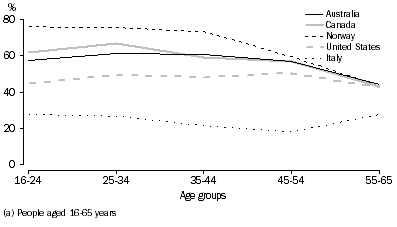
STATE AND TERRITORY
Examining the proportion of those who attained literacy scores of Level 3 or above, the Australian Capital Territory (ACT) ranked highest on all scales followed by Western Australia (WA) and South Australia (SA). For the prose and document scales, 68% of those in ACT attained literacy scores of Level 3 or above, compared to 56% in WA and 55% for prose and 54% for document literacy in SA. On the numeracy scale, 63% of those in the ACT attained literacy scores of Level 3 or above, compared to 49% for SA and WA. While the ACT was ranked highest on the problem solving scale, with 46% attaining Level 3 or above, the results were similar across all other states and territories, ranging from 27% to 31% (table 3).
Tasmania had the highest proportion of people aged 15 to 74 at Level 1 of all the states and territories for each literacy scale. The ACT recorded the lowest proportion of people at Level 1 and the highest proportion of people at Level 4/5 on each literacy scale
(table 3).
Some of the differences between states and territories in literacy performance may be due to differences in the socio-demographic characteristics of their populations, including variations in age structures, labour force status, patterns of migration and educational attainment.
EDUCATION STATUS
Attainment
There was a strong association between educational attainment and achieved literacy levels. People who had completed a qualification generally had higher literacy scores. For both the prose and document literacy scales, 64% of persons who had completed a qualification achieved Level 3 or above, compared to 41% for those who had not completed such a qualification. On the numeracy scale, 58% of persons who had completed a qualification achieved Level 3 or above, compared to 35% for those who had not completed a qualification (table 10).
In addition, those that had completed a greater number of years of formal education achieved higher literacy scores across all scales. Those with 21 or more years of formal education had the highest proportion of scores at Level 4/5 ranging between 40% and 43% on the prose, document and numeracy scales and 18% on the problem solving scale. In contrast, those with 10 or fewer years of formal education had the highest proportion of scores at Level 1 for these scales (between 33% to 59%) (table 10).
5 Prose literacy by Years of formal education, Level 1/2 compared with Level 3 or above
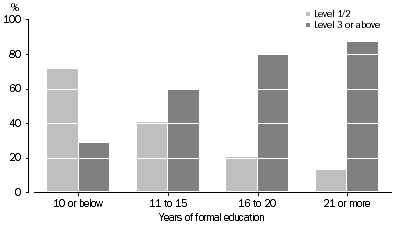
Participation
There were approximately 13.4 million people who reported participating in learning in the 12 months prior to the survey. Learning includes formal learning which is participation in an educational program to obtain a formal qualification. In addition, learning includes informal learning (but not as part of a course) which involves activities such as visiting trade fairs, professional conferences or expos, attending lectures, seminars or workshops, reading manuals or reference books or using computers or the Internet. For the prose, document and numeracy scales, people who participated in learning in the 12 months prior to the survey were more likely to achieve scores at Level 3 or above than those who did not participate. For both prose and document literacy, 58% of people who had participated in learning in the 12 months prior to the survey achieved scores at Level 3 or above. In comparison, for people who had not participated in any form of learning in the 12 months prior to the survey, 19% and 18% achieved scores at Level 3 or above for prose and document literacy respectively. On the numeracy scale, 52% of people who had participated in learning in the 12 months prior to the survey achieved scores at Level 3 or above compared to 14% of those who had not participated (table 11).
Looking at formal learning, of the 6.7 million people who undertook a course leading to an educational qualification in the previous 12 months, 69% achieved scores at Level 3 or above for both prose and document literacy, 61% for numeracy and 42% for problem solving. In contrast, of the people who did not undertake such a course in the previous 12 months, 42% achieved scores at Level 3 or above for prose literacy, 41% for document literacy, 37% for numeracy and 20% for problem solving (table 11).
LABOUR FORCE
Across all the scales, those employed had the highest proportion with scores of Level 3 or above (prose 60%, document 61%, numeracy 56%, problem solving 36% and health literacy 47%). Those not in the labour force had the highest proportion assessed at Level 1 or 2 for the prose (63%) and document (67%) scales, while for numeracy, the unemployed had the highest proportion attaining Level 1 or 2 (73%). For the health literacy and problem solving scales, the unemployed and those not in the labour force had the highest proportion assessed at Level 1 or 2 (75% and 84% respectively)
(table 12).
6 Skill level, proportion at level 3 or above, by Labour force status
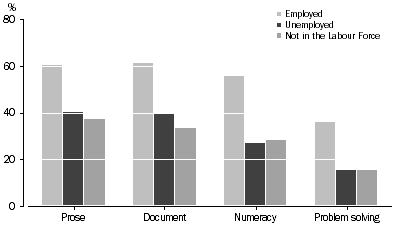
Employed persons
From 1996 to 2006, prose and document literacy scores for employed people has shown no statistically significant changes across most age groups. The exception to this was for employed people aged 25 to 34 years who attained scores at Level 4/5 on the prose scale, decreasing from 25% in 1996 to 21% in 2006 (table 16).
On the document scale, 68% of employed people who read letters, memos or emails at least once a week attained scores at Level 3 or above. Conversely, 32% of employed people who never read letters, memos or emails had scores at Level 3 or above. These results were similar for frequency of reading or using reports, articles, magazines or journals; manuals or reference books including catalogues; and directions or instructions (table 17).
On the numeracy scale, 60% of employed people who count or read numbers to keep track of things at least once a week attained scores of Level 3 or above. In contrast, 25% of employed people who never count or read numbers to keep track of things had scores at Level 3 or above. For employed people who write or fill in bills, invoices, spreadsheets or budget tables at least once a week, 64% attained scores at Level 3 or above, while of those who never perform these tasks, 40% attained scores at Level 3 or above (table 18).
INCOME
The median personal gross weekly income reported in the survey for Australia was $600. The median weekly income for those who attained literacy scores at Level 3 on the prose scale was $695. For those who attained literacy scores at Level 4/5 on the prose scale, the median weekly income was $890. People who attained scores lower than Level 3 on the prose scale, had a median weekly income less than $504 (table 8).
For employed people at Level 1 on the prose scale, 32% received a personal gross weekly income in the highest two personal income quintiles, compared to 59% for those with scores at Level 4/5. The results on the document scales were similar, with 31% of employed people with scores at Level 1 and 60% with scores at Level 4/5 receiving a personal gross weekly income in the highest two quintiles (table 16).
7 Document literacy by Personal gross weekly income quintiles for employed people, Level 1 compared with Level 4/5
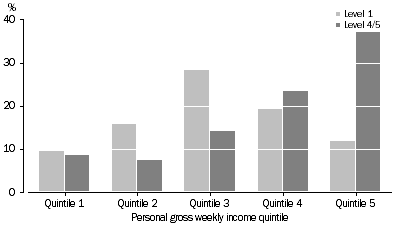
INFORMATION COMMUNICATION TECHNOLOGY
Those with higher literacy scores (Level 3 or above) were more likely to have used the Internet. Of those with literacy scores at Level 3 or above on the document scale, 79% used the Internet for email at least a few times a week compared to 40% of people with scores at Level 1 or 2. In addition, 64% of people with scores at Level 3 or above used the Internet for shopping at least a few times a month, compared to 33% for those at Level 1 or 2. These results were similar for people who used the Internet for banking or general browsing (table 24).
SELF RATING VS ASSESSED LITERACY
Prose and Document literacy
Over half of the population (53%) rated their English reading skills for the needs of daily life as excellent. Of this population, 71% achieved a literacy score at Level 3 or above on the prose scale and 68% on the document scale. Only 4% of people responding to the survey rated their English reading skills for the needs of daily life as poor compared with 17% who achieved a literacy score at Level 1 on the prose scale and 18% on the document scale. Of those who rated their English reading skills for the needs of daily life as poor, 83% achieved scores at Level 1 on the prose scale and 81% on the document scale (table 20).
Numeracy
For numeracy skills, 67% of people responding to the survey agreed or strongly agreed that they received good grades in maths. Of this group, 56% achieved numeracy scores at Level 3 or above on the numeracy scale. Similarly, 43% of males and 28% of females strongly agreed with the statement that they are good with numbers and calculations. Of this group, 40% of females achieved numeracy scores at Level 1 or 2 while 29% of males achieved scores at Level 1 or 2 (table 21).
PERSONS WHOSE FIRST LANGUAGE WAS NOT ENGLISH
The ALLS was conducted in Australia's official language, English. Examining the literacy skills of people whose first language was not English, 36% of this group achieved scores at Level 3 or above on the prose scale and 38% on the document scale, compared to 54% and 53% respectively for the general population (table 19).
Compared to 1996, of the people who migrated to Australia in the five years prior to the survey whose first language was not English, there was a statistically significant increase in the proportion of people attaining literacy scores of Level 3 or above on both the prose and document scales. On the prose scale, the proportion of this group with scores at Level 3 or above increased from 22% to 38% while on the document scale the proportion increased from 32% to 50% (table 19).
 Print Page
Print Page
 Print All
Print All